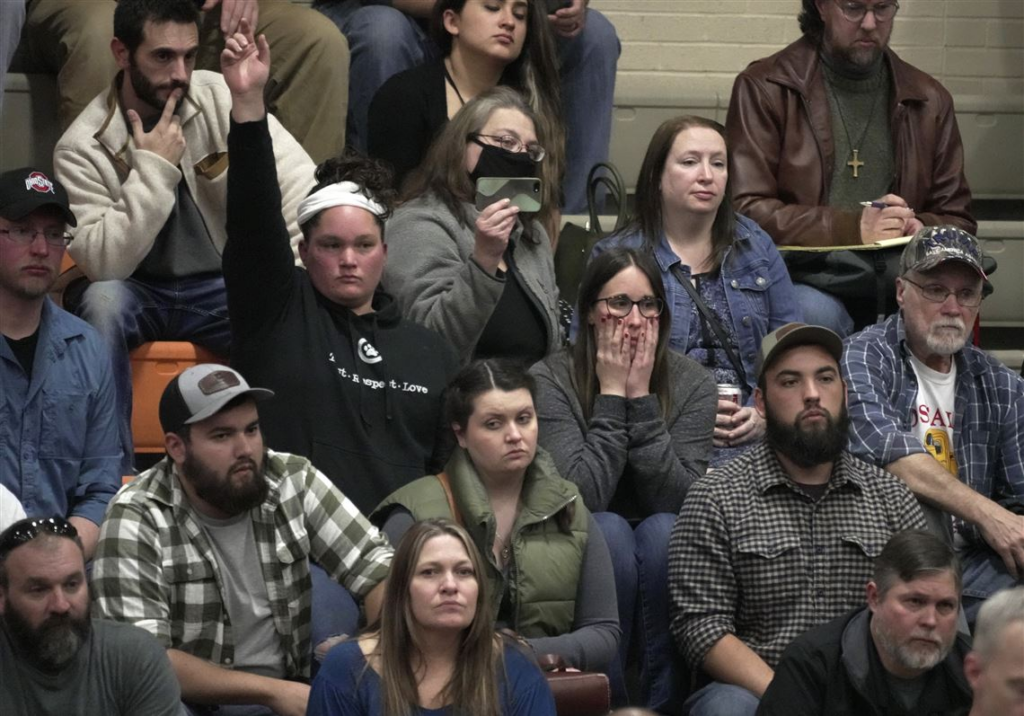
By Stephen Lester.
Shortly after the horrific Norfolk Southern train derailment occurred in East Palestine, OH, I was invited to attend a town hall meeting organized by River Valley Organizing. The purpose of the meeting was to give people the opportunity to ask questions and hopefully, get some answers.
This was about 3 weeks after the rail company made the decision to spill the contents and then burn 5 tanker cars holding vinyl chloride and other toxic chemicals into a ditch alongside the railroad tracks at the site of the 38-car derailment. This intentional burn unleashed a gigantic black cloud full of particulates that enveloped the surrounding neighborhoods and farms in both Ohio and Pennsylvania (the accident was just a few miles from the state border).
It is well documented that burning chlorinated chemicals like vinyl chloride will generate dioxins. Dioxin is the name given to a group of persistent, very toxic chemicals that share similar chemical structures. The most toxic form of dioxin is 2,3,7,8-tetrachlorodibenzo-p-dioxin or TCDD. TCDD is more commonly recognized as the toxic contaminant found in “Agent Orange” and at Love Canal, New York and Times Beach, Missouri. Dioxin is not deliberately manufactured. Rather, it is the unintended by-product of industrial processes that use or burn chlorine. It is also produced when chemicals like vinyl chloride are burned, such as what occurred in East Palestine.
At the town hall meeting, people talked about what it was like when the black cloud reached their property. One person who lived 15 miles away described burned ash material from the fire that settled on her property. Another who lived 3 miles away described how the black cloud completely smothered his property. People repeatedly asked: Was it safe for my kids to play in the yard? Is it safe to grow a garden? What is going to happen to my farm animals?
As I sat there listening, I was struck by how similar the questions were to what I had encountered when working at the Love Canal landfill in Niagara Falls, NY more than 40 years ago. People were raising important questions that deserve to be answered. But there were no clear answers. Just as it was at Love Canal.
It was also eerie how similar the response by the government authorities has been. Just like at Love Canal, the people of East Palestine are being told there’s no cause for alarm, that all the testing shows that no chemicals have been found at levels of “concern.” And just like Love Canal, the people in East Palestine are not buying it because they know things are not right. They are suffering from a range of respiratory and central nervous system symptoms including headaches, nose bleeds, runny noses, tearing eyes, and more.
As occurred at Love Canal, government scientists are not being honest with the people at East Palestine. If they did that, they would tell them what they know and what they don’t know. That would be helpful. But government won’t do that, because if they do, if they acknowledge how little is known about the link between adverse health effects and exposures to mixtures of chemicals, the people of East Palestine would demand action in the face of the huge uncertainties. Actions like paying for people to relocate from the area so that they can stop being exposed to the toxic chemicals – which are still in the air – or getting the health care they need and moving on with their lives.
It’s also unfortunate that so little had changed in the science of what we know about what happens to people who have been exposed to mixtures of chemicals like what occurred in East Palestine. This might have been understandable 40 or so years ago, but not today. It’s inexcusable that we didn’t learn from Love Canal and are repeating the same mistakes because we still know very little about widespread exposures to chemical mixtures.
The people in East Palestine deserve to be treated with respect and dignity and that includes expecting their government to act to protect their health in the face of the many uncertainties that exist in understanding the adverse health effects that result from these exposures. It’s time to do right by the people of East Palestine.


